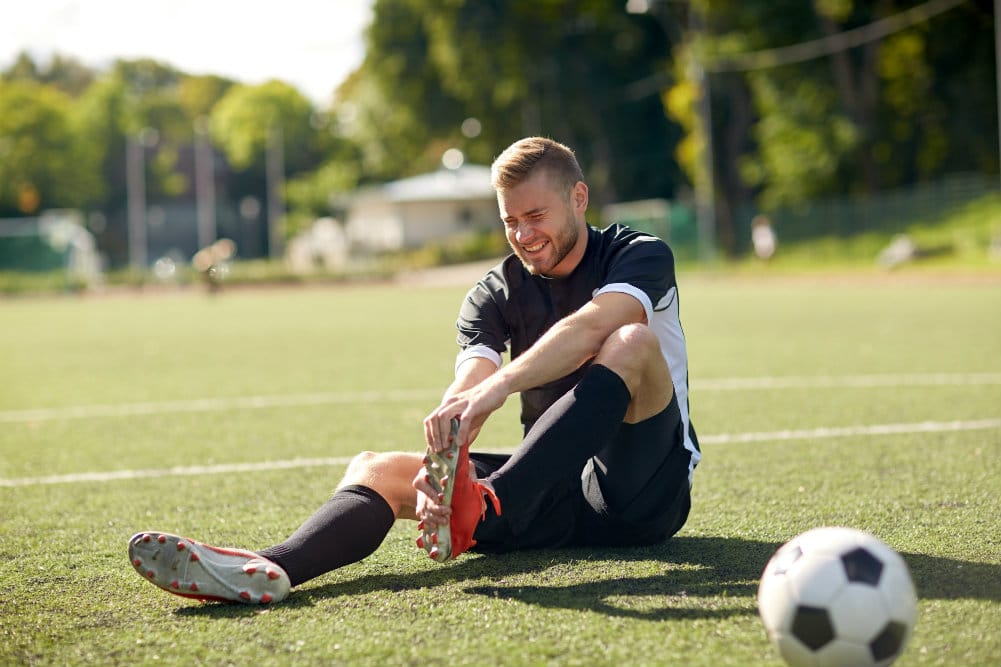Turf Toe
Turf toe is a tough sports injury for anyone to deal with. This painful (and for many active athletes, potentially debilitating) condition occurs when you sprain the ligaments supporting the joint at the base of your great toe, usually due to hyperextension of the toe.
Causes of Turf Toe
Consider the following scenario: a running back tries to change direction to avoid a hit. He’s just about to push off with his right foot—the heel of his cleat is in the air, but the toe is still flat on the ground. At that precise moment, he’s hit from behind, extending the toe beyond its limits. The ligaments of the toe stretch or tear, and the running back is looking forward to at least a couple weeks of recovery.
Turf toe gets its name because it’s especially common on artificial turf (which tends to have less “give” than natural grass), but football players are hardly the only victims. Anybody who plays sports or activities with lots of running and/or jumping are at increased risk; hard surfaces and especially flexible soles on shoes are other risk factors.
Although most cases emerge from a single traumatic episode, occasionally turf toe can result from smaller, repetitive hyperextensions. In such situations, the pain may come on slowly and get worse over time.
Symptoms of Turf Toe
Like other sprains, turf toe is generally classified into grades, each stage involving progressively more severe damage and symptoms:
- Grade I: The ligaments are stretched but not torn. There may be some swelling and tenderness, but usually not severe pain.
- Grade II: Ligaments are partially torn. Swelling and tenderness are worse, and bruising may be present. Range of motion in the toe is reduced, and moving it is painful.
- Grade III: Ligaments are completely torn. Swelling, tenderness, bruising, and pain are often severe. Moving the toe to any degree can be very difficult and painful.
Turf Toe Treatment
Immediately after the injury, you should practice good first aid techniques. Remember the acronym RICE: rest, ice, compression, and elevation. Getting weight off the foot and using ice or cold packs, compression, and raising it above heart level whenever possible can all help reduce pain and swelling and give your ligaments a better chance to heal.
Further medical treatment will depend on both the severity of the sprain and your personal goals. For turf toe at Grade I, simple approaches such as RICE and “buddy taping” the biggest two toes together for a time may be sufficient to allow healing. You may even be able to resume athletic activity with the aid of a stiffer-soled shoe, though you should clear it with us first.
A more serious Grade II sprain will probably require at least a brief period of immobilization to protect the torn ligaments while they heal. A walking boot may be needed for a few days to a week or two. The most serious injuries (Grade III) will require a longer period of immobilization (and possibly a cast), typically several weeks. You may also require a bit of exercise and physical therapy in order to rebuild strength and flexibility in the joint after the healing process is complete.
Surgery remains in the “back pocket” for serious cases, but generally we consider this a last resort only. Usually it’s only performed in rare cases where immobilization doesn’t produce the desired results, or if there are other complicating factors (such as fracturing or chipping of bones, or a nearby deformity such as a bunion).
Call the Kansas Foot Center for Help with Your Turf Toe Injury
Turf toe can be incredibly frustrating, especially for athletes who want to get back in the game but can’t run or push off without pain. This is definitely not an injury you should try to push through on your own—let our experts help you to ensure that healing and rehabilitation occur as safely, effectively, and quickly as possible. To set up an appointment at our offices in Wichita or Newton, please call 866.222.5177 today.

